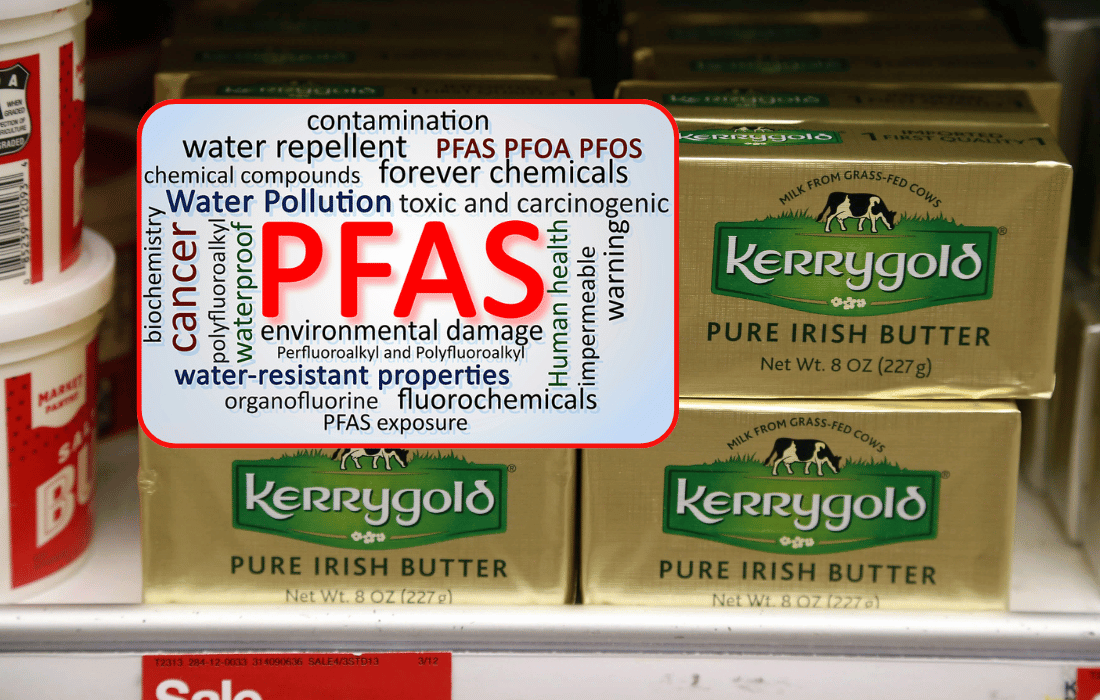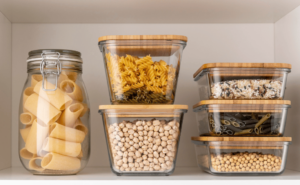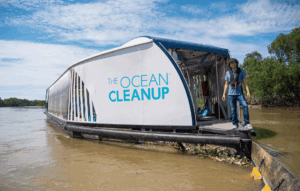If you’ve ever reached for a gold-wrapped stick of Kerrygold butter, you probably felt pretty good about it. It’s Irish. It’s made from grass-fed cows. It’s got that whole “straight-from-the-pasture” energy. For a lot of us, it’s the butter that makes us feel like we’re doing something right – a small indulgence that’s also “better” for us.
But in 2023, a class action lawsuit dropped a reality check on that image. The claim? That Kerrygold’s signature foil-wrapped butter, labeled as “Pure Irish Butter”, was actually wrapped in packaging laced with PFAS, the infamous “forever chemicals.” Suddenly, that grass-fed glow dimmed a little.
The lawsuit has since been dismissed, and Kerrygold has updated its packaging to comply with California and New York’s PFAS bans. But the bigger takeaway? This wasn’t just about Kerrygold. It was about all of us and all the food packaging we barely think twice about.
Let’s get into it.
What Are PFAS, and Why Should You Care?
PFAS (per- and polyfluoroalkyl substances) are a class of synthetic chemicals used to make things resistant to water, grease, and stains. They’re in everything from rain jackets to nonstick pans to – you guessed it – food packaging.
They’re called “forever chemicals” because they don’t break down. Not in the environment. Not in our bodies. Once they’re in, they stick around for a long time. And they accumulate.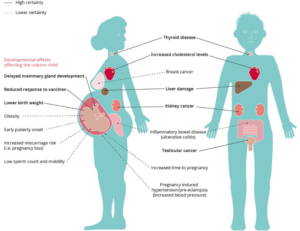
The health effects? Not pretty. Research has linked PFAS to:
- Hormonal disruption
- Reproductive and developmental issues
- Immune suppression
- Increased risk of some cancers
- Liver damage
- Lower birth weights and fertility concerns
The list goes on… even at low levels, PFAS can cause serious damage over time. And one of the most common ways we get exposed? Our food.
The Kerrygold Lawsuit: “Pure Irish Butter” Under Fire
In Winans v. Ornua Foods North America, a class action lawsuit alleged that the foil packaging used on Kerrygold’s salted and unsalted butter sticks contained PFAS, despite being marketed as “pure” and targeted at health-conscious consumers.
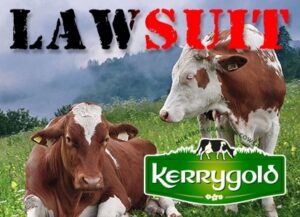 The issue wasn’t the butter itself, it was what it was wrapped in. According to the complaint, Kerrygold butter was pulled from shelves in New York and California, two states with new regulations banning PFAS in food packaging.
The issue wasn’t the butter itself, it was what it was wrapped in. According to the complaint, Kerrygold butter was pulled from shelves in New York and California, two states with new regulations banning PFAS in food packaging.
The plaintiff argued that Kerrygold’s branding was misleading. Words like “pure” imply a clean, chemical-free product. But if the packaging introduces toxic, man-made chemicals into your food? That’s a problem.
The lawsuit claimed the presence of PFAS – intentional or not – was inconsistent with the product’s image and could mislead reasonable consumers. It wasn’t just about health, either. It was about trust.
The case was ultimately dismissed “with prejudice,” meaning it can’t be refiled, and no settlement was disclosed. Kerrygold, for its part, made changes to its packaging and quietly returned to shelves.
But for many of us, the damage was done.
The Bigger Picture: Toxic Food Packaging Is Everywhere
Kerrygold is just one example in a much bigger issue: our food may be clean, organic, or even grass-fed, but if it’s touching packaging that’s full of endocrine disruptors or industrial toxins, all bets are off.
Let’s break down some common packaging offenders:
Canned Food Liners
Most canned foods – think beans, soups, tomatoes – are lined with plastic to prevent corrosion. For years, that plastic was made with BPA, a chemical linked to hormonal issues, infertility, and developmental problems.
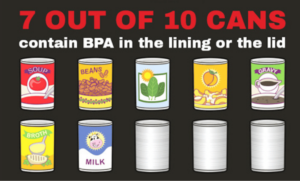
These days, you’ll see a lot of “BPA-Free” labels. But that doesn’t always mean safer. Many companies have swapped BPA for BPS or BPF, which are chemically similar and may have equally disruptive effects.
The problem is worse when the can is heated or contains acidic contents (hello, canned tomatoes). That’s when leaching into food is most likely.
Plastic-Coated Coffee Cups
Most paper coffee cups aren’t just paper, they’re lined with polyethylene, a type of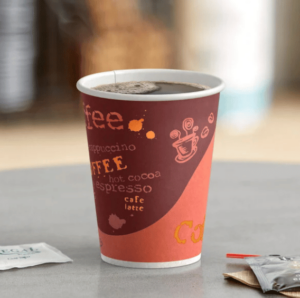 plastic that keeps hot liquids from soaking through. Unfortunately, that plastic can break down when exposed to heat, releasing microplastics and chemical residues into your drink.
plastic that keeps hot liquids from soaking through. Unfortunately, that plastic can break down when exposed to heat, releasing microplastics and chemical residues into your drink.
One 2020 study found that just one cup of hot coffee in a paper cup can release thousands of microplastic particles. And here we are sipping our oat milk lattes, thinking we’re making healthy choices.
To make things worse, these cups are rarely recyclable, due to the plastic-paper hybrid construction.
Black Plastic Containers (Sushi Boxes, Takeout Trays, etc.)
This one might surprise you. Black plastic – commonly used in sushi trays, microwaveable meal containers, and high-end takeout – is often made from recycled electronics.
That means it can contain flame retardants, heavy metals like lead and cadmium, and other industrial toxins. According to researchers like Dr. Rhonda Patrick, heating food in these containers – or even storing hot food in them – can cause harmful substances to leach into your meal.
Worse still, black plastic is difficult for recycling machines to detect, meaning it usually ends up in a landfill. So not only is it sketchy for your health, it’s bad for the planet too.
Grease-Proof Takeout Boxes and Pizza Boxes
A lot of paper-based fast food packaging is coated with PFAS to make it grease-resistant. If you’ve ever seen a pizza box that stays perfectly dry despite all that oily cheese, you’re probably looking at PFAS.
The FDA has banned some PFAS in food contact materials, but not all. And many companies use alternatives that haven’t been thoroughly tested for long-term safety.
So even your “eco” takeout box might be doing more harm than good.
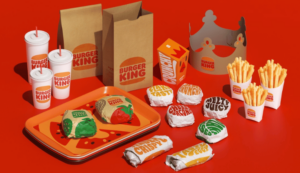
Greenwashing: When “Natural” Isn’t So Natural
Let’s talk about the marketing side of this.
Kerrygold isn’t alone in using feel-good words like “pure,” “natural,” or “clean.” These terms aren’t regulated by the FDA or USDA. Anyone can slap them on a label.
When consumers see “Pure Irish Butter,” they assume the entire product, from the ingredients to the packaging, is clean and safe. That assumption is exactly what companies are banking on. But when the packaging is chemically compromised, the brand is, too.
This is greenwashing 101: making a product seem eco-friendly or safe without doing the work. And when the stakes are your hormonal health or cancer risk, the consequences are way more than cosmetic.
How To Protect Yourself: Smarter Choices for a Less Toxic Kitchen
You can’t avoid all toxins, but you can reduce your exposure. Here are some quick wins:
- Ditch plastic containers (especially black ones). Use glass or stainless steel for storage and reheating.

- Buy butter wrapped in parchment or wax paper, not foil.
- Make coffee at home using a French press, stainless steel pour-over, or moka pot.
- Avoid microwaveable meals in plastic trays – transfer to ceramic or glass before heating.
- Limit canned food, or choose brands that disclose what they use in their liners (and test for contaminants).
- Eat more fresh, bulk, and unpackaged foods when possible; less packaging = fewer unknowns.
- Look for brands that disclose PFAS-free certifications, especially for packaging.
Final Thoughts: What This All Really Means
The Kerrygold lawsuit didn’t just expose one brand – it exposed a blind spot in how we think about health. We’re conditioned to focus on ingredients, macros, and sourcing. But what about the stuff our food touches? What about the packaging it sits in for days, weeks, or months?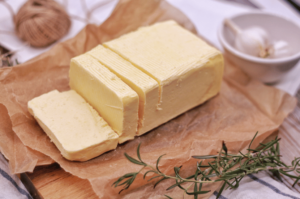
We’ve reached a point where packaging matters just as much as what’s inside. It’s time we stop assuming that a “natural” label means safe, and start asking harder questions. We deserve transparency, not just on what we’re eating, but what it’s stored in, wrapped in, and marketed with.
Because at the end of the day, health isn’t just about what you put in your body; it’s about what your body is exposed to with or without your consent.
The Kerrygold gold foil might shine, but we cannot afford to fall victim to these greenwashing tactics.

